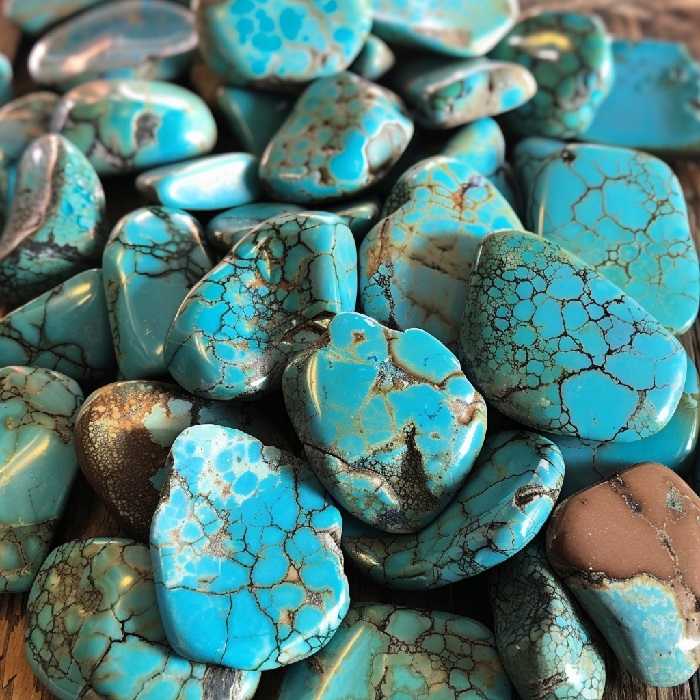Turquoise Mining
TURQUOISE:
Turquoise is a stone that has been valued for many years. The ancient Egyptians used turquoise in jewelry. Turquoise comes in colors like greenish-blue or pale sky blue. The term "turquoise" means "Turkish stone," as it came to Europe by way of Turkey. Turquoise is one of the oldest gemstones recognized, holding great wisdom and genuineness. This gemstone is a stone of self-understanding, helping somebody enhance their understanding of self-ideas and sentiments.
WHERE DO THEY FORM?
Turquoise forms when water percolates through rocks containing copper, aluminum, and other minerals. A chemical reaction occurs, resulting in deposits of what we know as turquoise. That's a basic way of describing a process that takes millions of years and only occurs when a complex set of conditions come together.
MINING PROCESS:
The journey of a turquoise stone commences deep within the earth's crust, where mineral-laden veins gradually form over millions of years. Within these veins, turquoise emerges in its natural, unrefined state. Turquoise deposits are scattered across diverse regions worldwide, including the United States, Iran, China, and Mexico.
Once a promising turquoise deposit is identified, mining operations commence. Techniques employed vary depending on the size and location of the deposit, ranging from manual tools to sophisticated machinery. Miners meticulously extract turquoise-bearing rocks to minimize any potential damage to the stones.
Following extraction, the turquoise undergoes sorting and stabilization procedures. This involves evaluating its color, clarity, and hardness to distinguish high-quality stones from those of lower grade. In some cases, stabilization treatments are applied to enhance the stone's durability and color, ensuring it withstands the rigors of cutting and shaping processes.
Turquoise Sorting and Stabilization
Following extraction, turquoise undergoes a sorting process to distinguish high-quality stones from lower-grade materials. This assessment focuses on the turquoise's color, clarity, and hardness.
In certain cases, turquoise undergoes stabilization to enhance its durability and color. This involves impregnating the stone with a clear resin to prevent fading and brittleness over time. Stabilization also improves the stone's ability to take on a polish, facilitating easier handling during cutting and shaping.
Cutting and Slabbing
After sorting and stabilization, turquoise is prepared for cutting and slabbing. Skilled lapidaries use specialized equipment like diamond saws and grinding wheels to shape the raw turquoise into usable pieces.
In the cutting process, the lapidary meticulously assesses the stone to determine its ideal shape and size. Often, slabs flat pieces of turquoise are cut to maximize the stone's potential. These slabs can be further crafted into diverse jewelry components, including cabochons and faceted stones.
TURQUOISE MINES IN WORLD:
Arizona turquoise mines
Sleeping Beauty Mine
Kingman Mine
Morenci Mine
Bisbee Mine
Castle Dome Mine
Nevada turquoise mines
Royston Turquoise Mine
Carico Lake Turquoise Mine
Battle Mountain Turquoise Mine
Blue Diamond Turquoise Mine
Lander Blue Turquoise Mine
Mexico turquoise mines
Cananea Turquoise Mine
Campitos Turquoise Mine
Cerrillos Turquoise Mines
Iran turquoise mines
Neyshabur (Nishapur) Turquoise Mines
Mashhad Turquoise Mines
Damghan Turquoise Mines
Sirjan Turquoise Mines
Chile turquoise mines
Laguna Verde Turquoise Mine
Manto Verde Turquoise Mine
Cerro San Cristobal Turquoise Mine
China turquoise mines
Ma'anshan Turquoise Mine
Hubei Turquoise Mines
Yunnan Turquoise Mines
Gansu Turquoise Mines
Tibet turquoise mines
Zhaxikang Turquoise Mine
Chuandidan Turquoise Mine
Dongchuan Turquoise Mine
Colorado turquoise mines
Cripple Creek Turquoise Mine
King's Manassa Turquoise Mine
Villa Grove Turquoise Mine
Southern California turquoise mines
Blue Gem Mine
Castle Dome Mine
Russia turquoise mines
Ural Mountains
Siberia
COMPOSITION:
- Associated Minerals: Pyrite, limonite, quartz, chert, cuperite, manganese oxide, apatite, chalcopyrite, chalcedony, and clays
- Density: 2.6 to 2.8
- Fracture: Concho dial
- Class: Phosphates
- Cleavage: None
- Colors: Mainly in shades of blue and Green
- Crystal System: Triclinic Bar 1
- Luster: Dull to Waxy
- Birefraction: 0.04
- Chemical Formula: CuAl6 (PO4)4(OH) 8*5(H2O),
- Chemical Name: Hydrated Copper Aluminum Phosphate
- Refractive Index: 1.61 to 1.65
- Specific Gravity: 2.60 to 2.80
- Transparency: Opaque
PHYSICAL PROPERTIES :
Beliefs About Turquoise:
In ancient times, turquoise was even regarded as a comforting material for the wearer. The Persian scholar Al-Qazwini, for instance, wrote: "The hand that wears a turquoise and seals with it will never see scarcity." Turquoise was often worn on turbans, sometimes surrounded by pearls, to protect the wearer from the "evil eye." As talismans, they adorned daggers, sabers, and horse bridles. It wasn't until the time of the Crusades that they came to Europe. Indeed, it is from that period that the name "Turquoise" originates, meaning "Turkish."
In South, Central, and North America, turquoise has also held a very special place among all gemstones. The Aztecs in Mexico, for instance, used to decorate their traditional masks with this stone, which was considered sacred according to their beliefs. The Native Americans, who still create a great deal of traditional silver jewelry with turquoise today, believe that the sky-blue gemstone establishes a direct connection between the sky and the sea.
Throughout the world, turquoise has been worn as a natural protective gemstone against the forces of darkness. If in ancient times they protected horse and rider from unexpected falls, they are now considered the protective stone of pilots, air crews, and other occupational groups exposed to a high level of risk.
In modern gemstone healing, those suffering from depression are advised to wear turquoise or a chain with turquoise beads. The optimistic color of turquoise is said to imbue quiet personalities with more confidence. It is a suitable gift to give, a stone of friendship, for turquoise is said to foster truthfulness and reliability in relationships.
Natural Occurrence
Iran (Nishabur and Kuh-e-Raies Mountain), Afghanistan, Tibet, China, USSR, Australia, Sinai Peninsula, and the USA (Arizona, California, Nevada, and New Mexico).
Available Colors
There is no ideal color for turquoise. The color depends on the chemical composition of the rocks. This is why none of the turquoise gems will have the same color. The color ranges between pale blue to bright green. High-quality turquoise is of a pure, glowing sky blue.

















